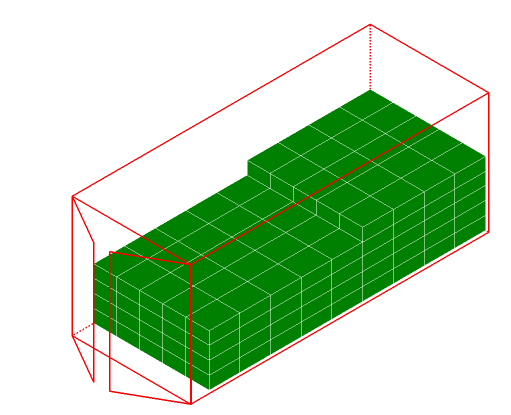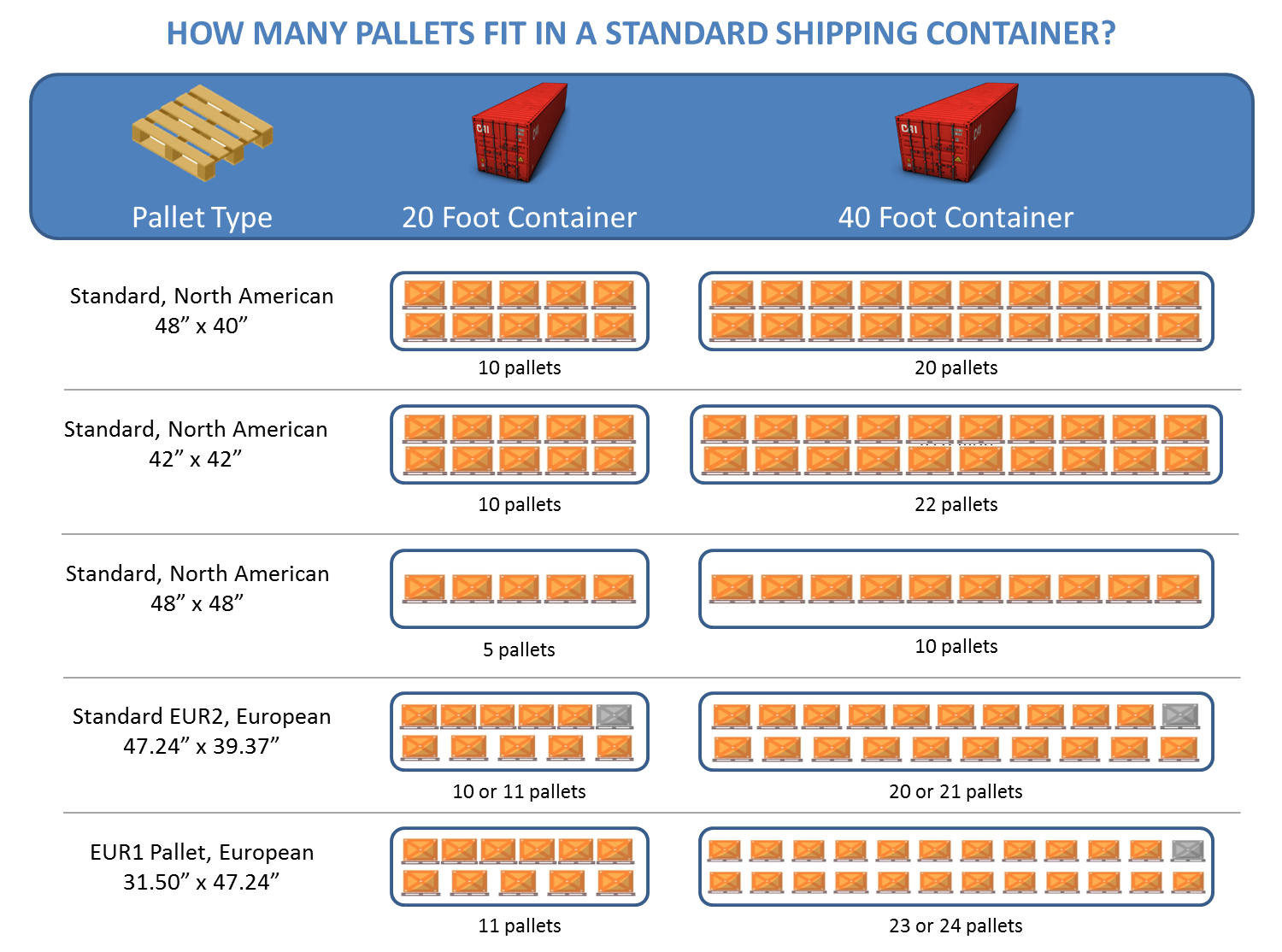Ocean freight is the most common mode of transportation used by exporters and importers all over the world. In fact, 90% of all goods shipped internationally are transported via ocean freight. While the other modes of international transport are faster, they are also more expensive.
When planning your overseas shipment, it is important to select the correct ocean container to suit your needs. Choosing the right size container not only saves you money, but it also key to ensuring your shipment arrives safely and in good condition.
Selecting the Right Container
The first step in determining the right container to suit your needs is to identify the type of cargo that you intend to ship. Are you transporting dry goods or liquid materials? Is the product heavy or voluminous? Does the cargo require refrigeration, insulation, ventilation, or special handling equipment? Will securing devices or special dunning be required?
Calculating Freight Volume
The next step is to calculate the freight volume of the shipment. Freight volume is the product of the length, times the width, times the height, times the quantity (number of items) to be loaded. Please note that the precise method of calculating freight volume will vary depending on the shape of the involved unit.
(Length x Width x Height) x Quantity
Step 1: Using a tape measure, determine the length, width, and height of the carton, box, or pallet. For instance, you have a shipment which includes 200 boxes, all the same size and weight. The boxes are 24 inches long, 18 inches wide, 10 inches high, and weigh 15 lbs.
Note: When calculating the volume of cylindrical packages, it is best to check with the carrier to see if they square the circle (the diameter becomes width and height).
Step 2: Multiply the length, width and height of a single box to determine the volume in cubic inches. Using this example, we get 4,320 cu. in. of volume per box.
24 x 18 x 10 = 4,320
Step 3: Convert the cubic inches to cubic feet by dividing the total volume of cu. in. by 1728. For this example, we get 2.5 cu. ft.
4,320 ÷ 1728 = 2.5
Step 4: Multiply the number of boxes (quantity) by the volume of a single box. In this example, the total freight volume is 500 cu. ft.
200 x 2.5 = 500
Step 5: If your shipment includes a variety of different shapes and sizes being loaded (batches), simply repeat the formula for each size and then add the batch volume totals together to calculate the overall freight volume for the entire shipment.
Step 6: Calculate the overall weight of the payload (total weight of the cargo) by multiplying the quantity by the weight of each item to be loaded. Using this example, the total payload weight is 3,000 lbs.
200 x 15 = 3,000 lbs.
Step 7: Convert the pounds to kilograms by multiplying the number of pounds by 0.45359237. The total weight in kilograms for this shipment is 1,360.78.
3,000 x 0.45359237 = 1,360.78
Step 8: Next, calculate the cubic weight (in pounds) of the shipment by the total cubic feet. The total cubic weight for this shipment is 6 pounds per cubic feet.
3,000 ÷ 500 = 6
Determining Load Capacity
Now we know that the total capacity (freight volume) for this shipment is 500 cu. ft. and the total weight is 1,360.78 kg. The next step is to translate that capacity into the appropriate container.
As there are an unlimited number of sizes and types of shipping containers, this article will focus on the three most popular standard containers: the 20-foot container, 40-foot container, and 40-foot high cube container. For more information on non-standard shipping containers such as flat rack, open top, temperature controlled, or other specialty containers, please contact your OCEANAIR representative.
Review the container specifications below to see which container could possibly accommodate this shipment.
20-Foot Container*
| Interior Dimensions: | 19’ 5”’ length x 7’ 8” width x 7’ 9” height |
| Door Dimensions: | 7’ 6” width x 7’ 5” height |
| Floor Space: | 148.86 cu. ft. |
| Usable Capacity: | 1,169 cu. ft. (33.2 cbm) |
| Tare Weight (empty): | 5,181 lbs. (2,350 kg) |
| Weight (max payload): | 32,500 lbs. (14,742 kg) |
| Weight (max gross): | 71,650 lbs. (32,500 kg) |
A 20’ container can hold up to 10 standard 48″ x 40″ and 42″ x 42″ pallets, 5 standard 48″ x 48″ pallets, 11 standard EUR2 European pallets, or 11 EURO European pallets and can be loaded to a maximum payload of 32,500 lbs. (14,742 kg).
40-Foot Container*
| Interior Dimensions: | 39’ 6 ½” length x 7’ 8” width x 7’ 9” height |
| Door Dimensions: | 7’ 5 ½” width x 7’ 6” height |
| Floor Space: | 303.15 cu. ft. |
| Usable Capacity: | 2,377 cu. ft. (67.7 cbm) |
| Tare Weight (empty): | 8,267 lbs. (3,750 kg) |
| Weight (max payload): | 44,500 lbs. (20,865 kg) |
| Weight (max gross): | 71,650 lbs. (32,500 kg) |
A 40’ container can hold up to 20 standard 48″ x 40″ pallets, 22 standard 42″ x 42″ pallets, 10 standard 48″ x 48″ pallets, 21 standard EUR2 European pallets, or 24 EURO European pallets and can be loaded to a maximum payload of 44,500 lbs. (20,865 kg).
40-Foot High Cube Container*
| Interior Dimensions: | 39’ 6 ½” length x 7’ 8” width x 8’ 9 ½” height |
| Door Dimensions: | 7’ 7” width x 8’ 5” height |
| Floor Space: | 303.15 cu. ft. |
| Usable Capacity: | 2,684 sq. ft. (76.3 cbm) |
| Tare Weight (empty): | 8,598 lbs. (3,900 kg) |
| Weight (max payload): | 44,500 lbs. (20,865 kg) |
| Weight (max gross): | 71,650 lbs. (32,500 kg) |
Finding the Right FitThe primary difference between a 40-foot container and a 40-foot high cube container is the difference in height of exactly one foot. This additional height gives the 40-foot high cube container an extra 9.741 cbm of usable capacity. All the other specifications remain the same in terms of length, width, and available floor space.
For this example, our shipment meets the usable capacity and payload weight requirements for a 20’ standard shipping container. But let’s do some more calculating to ensure that we meet the height and width restrictions. We could configure the container with 5 boxes across the width of the container, 9 rows across the length, with 4 of the rows of 5 stacked boxes and 5 rows of 4 stacked boxes, as shown in the figure below, and then calculate how much space our load will take up.

Start by multiplying the length of a single box by the number of rows of boxes stacked front to back to calculate the total length of the load. The answer for this example is 216”. Then convert the inches to feet by dividing the total inches by 12, for a total of 18 feet.
9 x 24 = 216 216 ÷ 12 = 18
Next, multiply the width of a single box by the number of boxes stacked in a row across the width of the container to calculate the width of the load. The answer is 90”. Then convert the inches to feet by dividing the total inches by 12, for a total of 7’ 6”.
18 x 5 = 90 90 ÷ 12 = 7.5
Then multiply the height of a single box by the largest number of stacked boxes from the floor up to calculate the total height of the load. The answer for this example is 50”. Then convert the inches to feet by dividing the total inches by 12, for a total of 4’ 2’.
10 x 5 – 50 50 ÷ 12 = 4.16
This configuration would take up 18’ length, by 7’ 6” width, and 4’ 2” height, with a total weight of 1,360.78 kg. Based upon these calculations and a review of the most popular shipping containers, a 20-foot container is the most appropriate for the example above.
Considerations
- Keep in mind that 20′ shipping containers are designed to carry heavier cargo; 40′ containers are designed to carry voluminous cargo; and 40‘ high cube shipping containers are designed to provide additional space for stacking pallets or larger items.
- The specifications above are the industry’s averages, and equipment size or capacity may vary slightly.
- Usable capacity (volume) figures are based on a perfect load, with no empty space. It is impossible for most cargo to achieve these capacity figures.
- As a rule of thumb, the actual capacity within a shipping container is typically a little over 80% of maximum capacity.
- Weight limits are set differently by each shipping line. Be sure to check with your carrier to ensure your cargo falls within their specific guidelines.
- The limits stated above are the maximum allowed on U.S. roads. Heavier weight containers can be trucked, but special permits and equipment will be required.
- Load limits for trucking vary by country. Be sure to check the local requirements for your cargo’s en-route and final destinations.
- Be sure to check with the shipping line to determine if there are any restrictions and/or limitations on the amount of cargo you can load, which is dependent on the nature of the cargo and shipping details.
What if I don’t have enough goods to fill a 20-foot container?
Considering how much space is in a container, clearly some businesses will not be exporting enough to fill an entire container. If you have small items or are shipping smaller quantities, the logistics becomes a little trickier, but that doesn’t mean that you can’t benefit from the cost savings of ocean freight. One option for you to consider is Less than Container Load (LCL) shipping.
LCL shipping is when multiple businesses, who want to ship small volumes (usually less than 20 cbm), share a shipping container. This means that, instead of paying for the entire container, you only pay for the space within the container that you use.
Fortunately, there are many other companies who want to ship their products in a consignment with other companies. Contact your OCEANAIR representative to see how we may assist you in consolidating your shipment in order to take advantage of these competitive shipping rates.
Need Help?
Still having trouble figuring out what size container is best for your cargo? Feel free to contact your OCEANAIR representative. We will be happy to answer any questions you may have.
_______________
*Container specifications published by Hapag-Lloyd


